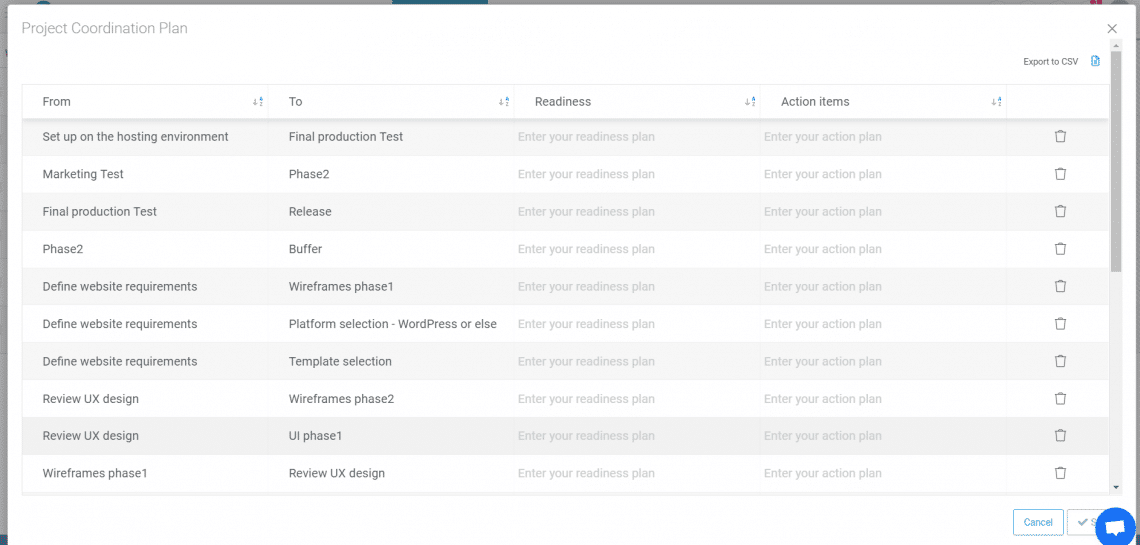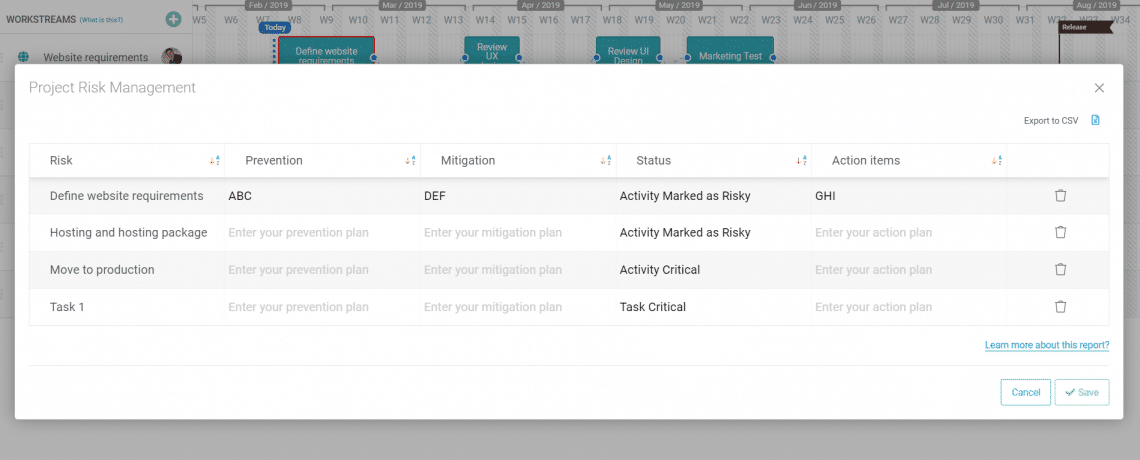5 Ways to Create Effective Project Plans


Creating realistic, effective project plans is the foundation for reaching successful delivery. If your plan isn’t attainable, the project will fail. If the plan has too many holes, the risk involved will sink the project before delivery. A building is only as strong as its foundation, and a project is only as strong as its plan. So how do you create project plans that will succeed? Here are the five steps to follow.
How to Create a Project Plan?
1) Plan By Workstreams, Instead of Individual Tasks
This is a Gantt chart. It lists the project by individual tasks, with the time assigned to each, and breaks down the project into actionable items.

Planning a project around a Gantt chart requires a detailed breakdown of the project into tasks, and draws your focus to what needs to be done. The more complex the project, the more unwieldy and complicated this becomes – and the more unusable and difficult to understand the project plan will be.
Instead of planning what needs to be done, plan around who are the project stakeholders, and how they will engage in project delivery. Workstreams are core areas of the project, divided by team, unit, person, or even location. By breaking the project into workstreams instead of tasks, you are defining the areas of interaction necessary for project success – and you are drawing your focus to the people responsible, rather than the tasks.

This is a ProjectMap™. The project is broken down by workstreams. Look at the difference in visual clarity and project communication compared to the Gantt – both examples are for event management, but one gives you a complete picture of the project focused on teams in the project, while the other is a more task-oriented bar chart schedule.
Planning by workstreams sets your project up for success from day one. Greater clarity, better planning mechanisms, and team-focused plans are building blocks for meeting delivery successfully.
2. Create the Right Connections and Dependencies
Dependencies are actually obstacles you’re identifying in advance. By saying task X is dependent on task Z, you’re in effect identifying task Z as something that requires monitoring and management in order for the project to progress. It is crucial to identify the right dependencies in a project plan, or your attention will be taken away from where it is needed.
Once you plan by workstreams, this becomes more readily apparent – items following each other in a workstream are automatically dependent upon one another. The team knows their path forward and will monitor the change from one task or activity to the next. Its when there are handoffs between teams – cross-team dependencies – where extra care needs to be taken to ensure smooth sailing. When something crosses from one workstream to another, you will need a coordination plan to ensure a successful handoff and project success.
3. Managing the Coordination Plan
Project coordination plans are designed to increase cohesion between teams handing items off to each other during the lifetime of a project. There is a lot to coordinate, too – take an example of the development team finishing a new feature and handing it off to the marketing team. The marketing team needs to get up to speed on the new feature’s capabilities and mechanisms, learn its uses, create promotional and educational material for customers and new users, etc.
Without a detailed coordination plan in place beforehand, things will fall through the cracks, people will be unprepared, and the level of project risk will skyrocket as marketing scrambles to gain its footing. If the handoff was planned and monitored three weeks beforehand, marketing will hit the ground running, and a smooth transition means little to no risk.
Effective coordination plans monitor the state of readiness for each handoff, and the action items needed to ensure a successful passing of the baton.

The ProjectMap™ has a built-in Coordination plan feature that lists every cross-team dependency you’ve created on your project plan and prompts you for the readiness plan and action items necessary to keep the project moving forward.
4. Engage with Your Team. They are the Best Source of Knowing What Is Realistic
Your team is your greatest resource. The more a project team is engaged, the more you as a project manager can utilize their knowledge and perspectives in your quest to achieve successful delivery.
How do you engage the team? It starts at the beginning. Project kickoff meetings are crucial in creating buy-in from the team. Reach for feedback. Include the team in the planning phase when possible. Be open and honest – “we need to have this milestone here because of stakeholder demands” – and include the team in finding the solutions needed. When your team is a part of the planning, as much as the plans, your project is on better footing.
Your project plan needs validation in its scope and ambitions. The best place to gain this is from the team. Bring them in early, and often, and your project will be better for it.
5. Manage Your Risks. It Isn’t Just Defining Risks but Handling It Effectively
Risk management is a crucial part of achieving successful delivery, but what goes into risk management is an important question. Too often, the path chosen is one of defining risks and attempting to avoid them – but this is not effective.
Recognizing risks is important, but it isn’t the end of the job. Everyone can identify the risk of driving a car on a winding mountain road in the pouring rain. Not everyone can successfully avoid it, and even fewer people can navigate under those conditions without an accident. The same is true in your project! Defining the risk is only step one. You need an avoidance plan, and a mitigation plan on top of that – and ideally, you want to move the risk to a second level with Backwards Risk Calculation. [link to BRC article there]
Proggio includes a risk planning system in the ProjectMap™, where every identified risk and every item marked critical are included in the risk management tool.

The tool prompts you to create a risk management plan, with prevention and mitigation plans, for each item necessary in the project plan.
Summary: Effective Project Plans
Effective and reliable project plans share 5 characteristics:
- Plans built on workstreams
- Properly identified dependencies
- Coordination plans to mitigate dependency risk
- Team engagement in the planning and operational stages
- Robust risk plans
Tools like Proggio provide all five. Ensure your project is set up to succeed – use Proggio! Free plans available today.